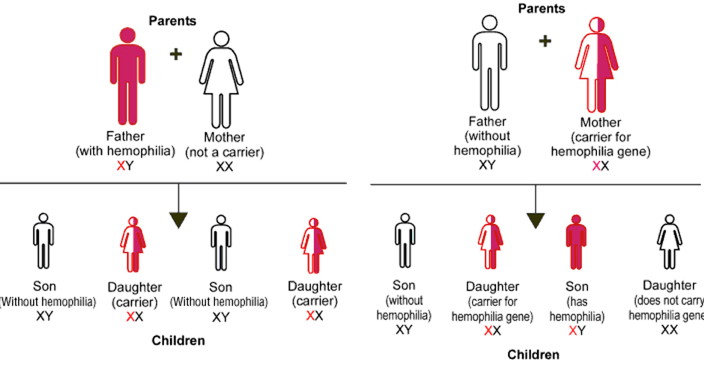Pediatric Hematology/Oncology – Hemophilia B
What is Hemophilia B?
Hemophilia is a rare, inherited bleeding disorder in which blood cannot clot (form a mass) normally at the site of a wound or injury. The disorder occurs because certain blood clotting factors are missing or do not work properly. Because a clot does not form, extensive bleeding can be caused from a cut or wound. Spontaneous internal bleeding can occur as well, especially in the joints and muscles.
Hemophilia affects males only, but there are rare circumstances when a female can be affected with the disorder. Hemophilia B is less common, affecting 1 in 25,000 to 30,000 males. Type B is caused by a deficiency of factor IX, one of the proteins that helps blood to form clots.
Symptoms
Prolonged external bleeding after trauma and bruising that occurs easily or for no apparent reason, are two major symptoms of hemophilia. Symptoms vary depending on whether the patient has the mild, moderate, or severe form of the disorder:
- In severe hemophilia, bleeding episodes occur often and with little or no provocation.
- In moderate hemophilia, prolonged bleeding tends to occur after a more significant injury.
- In mild hemophilia, a patient might have unusual bleeding only after a major injury, surgery, or trauma.
People with hemophilia may have any type of internal bleeding, but most often it is in the muscles and joints, such as the elbows, knees, hips, shoulders, and ankles. Often there is no pain at first, but if it continues, the joint may become hot to the touch, swollen, and painful to move.
Repeated bleeding into the joints and muscles eventually causes permanent damage, such as joint deformity and reduced mobility.
Bleeding in the brain is a very serious problem for those with severe hemophilia and may be life-threatening. Signs of bleeding in the brain may include changes in behavior, excessive sleepiness, persistent headaches and neck pain, double vision, vomiting, and convulsions or seizures.
Levels
Mild: In mild hemophilia, a person has 5% to 40% of normal clotting factor activity. The person might bleed for a long time after surgery or a very bad injury, or might never have a bleeding problem. They do not bleed often and generally do not bleed unless they are injured.
Moderate: In moderate hemophilia, a person has 1% to 5% of normal clotting factor activity. The person might bleed for a long time after surgery, a bad injury, or dental work. They might bleed about once per month. They rarely bleed spontaneously or for no clear reason.
Severe: In severe hemophilia, a person has less than 1% of normal clotting factor activity. The person bleeds often into the muscles and joints. They might bleed one or two times per week. They might bleed spontaneously, for no clear reason.
Genetic Disposition
Hemophilia is a sex-linked recessive bleeding disorder that is usually passed on through a parent’s genes. Genes carry messages that help the cells of the body work correctly. All genes are found on chromosomes. Remember, people are born with hemophilia; they cannot catch it from another person. A woman who has one normal X chromosome and one affected X chromosome is considered a carrier even if she does not have any symptoms of hemophilia herself, because the normal chromosome compensates for the affected gene. She has a one in two chance of passing the hemophilia gene to her children, boy or girl. There is a 50% chance with each pregnancy that any son she has will have hemophilia and a 50% chance that any daughter that she has will be a carrier like herself.

Diagnosis
A doctor will perform a physical examination to rule out other conditions. If you have symptoms of hemophilia, the doctor will ask about your family’s medical history, since this disorder tends to run in families. In children with severe hemophilia, the diagnosis is usually made in infancy, either at circumcision, or when the toddler starts to walk and sustains minor injuries when falling.
Blood tests are then performed to determine how much factor IX is present. These tests will show whether the hemophilia is mild, moderate, or severe, depending on the level of clotting factors in the blood. Anyone born with hemophilia will have it for the rest of their life. Currently there is no cure for hemophilia.
Treatment
Treatment depends on the type and severity of the disorder. It consists of replacement therapy, in which human plasma concentrates or recombinant (produced from DNA) forms of clotting factor IX are given to replace the blood clotting factors that are missing or deficient.
During replacement therapy, the clotting factor is injected or infused (dripped) into a patient’s vein. Usually, people with mild or moderate hemophilia do not need replacement therapy unless they are going to have surgery or have a significant injury or trauma.
In cases of severe hemophilia, treatment may be given to stop bleeding when it occurs. Patients who have frequent bleeding episodes may be candidates for prophylactic factor infusions. These are given two or three times per week to prevent bleeding from occurring.
Resources
- Playing it Safe
- National Hemophilia Foundation
- World Federation of Hemophilia
- The Hemophilia Alliance
- Steps for Living
- Arthritis Foundation
- Developmental Milestones (PDF)
Services
Comprehensive exam annually, follow-up visits for ongoing bleeding disorder complications, education, contact with local healthcare providers and hospitals, blood tests and x-rays, financial and/or emotional counseling with a social worker, help coordinating genetic counseling for potential parents, physical therapy and interventions including musculoskeletal exams, aquatic therapy and child life support for patients and their family.